The Allegory of Other Life
On a cool monsoon evening, I sat on a bench made of rock and
cement, crusted thinly by moss on a layer of black mass. This bench has been
here for not more than a year, and this is its first season in the rain. Beside
this bench is a dense mass of grasses, sedges, and herbs like Common Balsam (Impatiens balsamina) and Pot Cassia (Cassia tora), growing taller than the
surrounding.
I sat gazing at this small island as thin raindrops settled
upon the blades and the spikes of grass. Like sitting on a safari vehicle, looking
out into the grass for signs of a crouching tiger, I looked on. A grass frond
sprang up from a corner of the island, the drops settled upon it now flying
through the air. Like a tiger shuffling after arising from a cool pond. A
grasshopper sat munching upon the blade of grass, right where the blade could
take its weight. Munching; engrossed. Like a tiger, I reminded myself, like a
tiger. A snail slowly made its way on the stem of the spikelet, just as another
started descending from another. The raindrops increased in size. And another
grass frond sprang up. The grasshopper sat munching, lolling on its
now-thinning blade of grass; the snail reached the spikelet of grass as the
other reached the base of the stem. The rain increased, and I looked for cover
under the Mahua (Madhuca latifolia)
tree across the island; its thick broad leaves a waterproof crown. From there I
noticed the island of grass was once a bench like the one I sat upon.
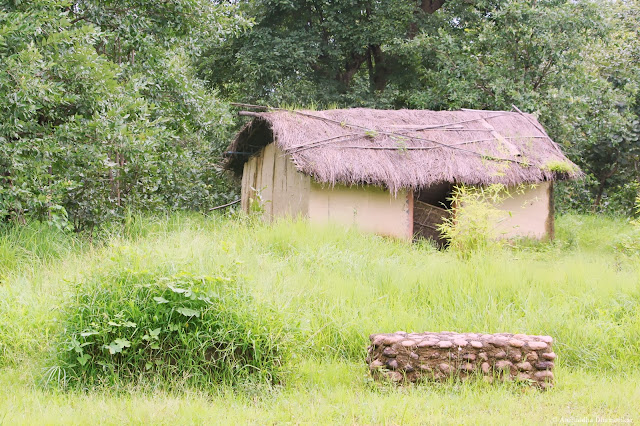 |
| The bench I sat upon |
The evening wore on quickly. I decided to write a short note
to remember this little moment, an allegory to the moments cherished, or
yearned for, by most visitors, once I reached the station. The rain persisted; filling
all the dents in the ground with crystal clear waters. A pair of Black Drongo
chased after Jungle Owlets as they went in search of a dry bough to roost in.
On dark mornings and evenings when thin rain allows for a
walk, birds, mammals, and reptiles, are all in hiding. The parks are closed,
and a general consensus lingers amongst many tourists that wildlife and monsoon
do not gel well. But monsoon is probably the only season of sheer adventure of
all. And one of the most unique to see the other life. Look at your feet, near
you, and you will see the other life, the life that encompasses over 75% of all
life: insects, spiders, and myriad forms of arthropods. They’re on leaves, on
ground, in tiny burrows, hanging in the air, wading on water or submerged under
it; chewing, biting, piercing, licking.
In a world under your feet lay a world quite visible but
believed invisible.
I sit every morning and evening observing these as and when
time permits. A troupe of ants, six strong, strode over the wet path one day,
dodging rain and tiny pools. If they sensed something fishy, or interesting,
with their tiny elbowed antennae, one ant would take the lead to investigate,
and invisibly signal others to come. They all would stand around the object of
interest, and, if disinterested, move on in a bunch after an antenna-to-antenna
discussion. I cannot help but allegorize these Camponotus ants with dwarves in search of lost treasure.
Under the Mahua hangs a light bulb reigned by a mighty horde
of Weaver Ants (Oecophylla smargdina),
their numbers, I reckoned, in multiples of thousand; like a thousand-strong
pack of Dhole (Cuon alpinus).
| The hunting pack of Weaver Ants (Oecophylla smargdina) |
Every night over a leaf under the shine of the light the
ants struggle to tear tiny insects in pieces, not to consume selfishly, but to
take them back to the nest and feed their larvae. On the platform surrounding
the tree, a myriad of beetles, ants, moths, and bugs roam and fly around haphazardly
– their motion signifying absolute randomness in the sea of an incandescent
light.
 |
| Insect trails |
Most of the beetles, moths, and bugs come here to seek the
warmth of the light. The ants, however, have different intentions. Be it the
penumbra or umbra of the light, the ants are heaving, panting, struggling,
pulling, and fighting, to get maximum of this bounty. Their nest is meters up
the tree, in total darkness, created out of leaves green and brown sewn
together by the larvae, their children.
In the morning this same place is clear of any struggle.
Only a few ants with raised antennae and open mandibles guard the trunk and
leaves of the Mahua. Elsewhere, where paths or forest clearings are free of
water, roam another kind of a predator named after the very tiger – the Tiger
Beetles.
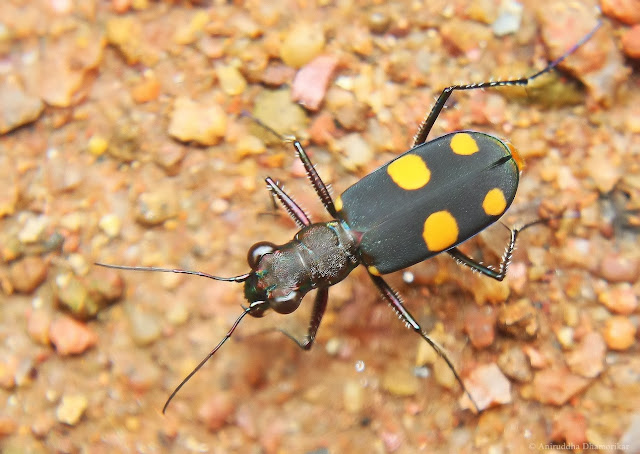 |
| The Tatooine Tiger Beetle (unofficial name) (Cicindela bicolor haemorhoidalis) |
They’re one of the ephemeras of Central India. The common
Tiger Beetles of Central India, to name a few, are C. bicolor haemorhoidalis, C.
viridilabris, Calochora flavomaculata,
and most probably Cicindela dasiodes
and C. undulata, however no one
really knows the real diversity of these beetles here, or the entire of
peninsular India for that matter. They chase after ants as tigers chase after
deer. They are said to be the fastest of all insects in the world, reaching
such preposterous speeds that research says they temporarily go blind.
 |
| Larva of a Tiger Beetle in its burrow |
Their adult life begins by June and comes to an end by
August; as fast as their flight. On one August evening along a muddy bank of a
paddy field I found little holes and heads popping in and out. These shy little
creatures were the grubs of the Tiger Beetles: infamous ant-killers. Any
passing ant within the reach of their heavily built mouth is a sure kill. How
they survive the rain, cold, and summer, until they can emerge out once again
as adult tiger beetles to rule the undergrowth, is a story of bravery and
struggle best left to our imagination.
Walking in grasses sends a number of insects flying in all
directions: moths, grasshoppers, beetles, are some of them. It is like walking
in a forest, your troll feet flushing out all that you could eat, if you get
the hyperbole. The grasses are their micro-habitat where they roost, feed, or breed.
Some would only emerge under the cover of darkness, while others would remain
here from birth to death – such as the grasshoppers.
These niches are no safe haven either. In here lurk the
master hunters of the other life – the Praying Mantises.
Mantis is the superb opportunist, capable of empowering
anyone smaller or bigger its size. Trouble one, and you’ll be sure to get a
good pinch from its saber-toothed raptorial legs. So brave is this hunter of
the undergrowth that it would even try to scare you with its superb display of
aggression.
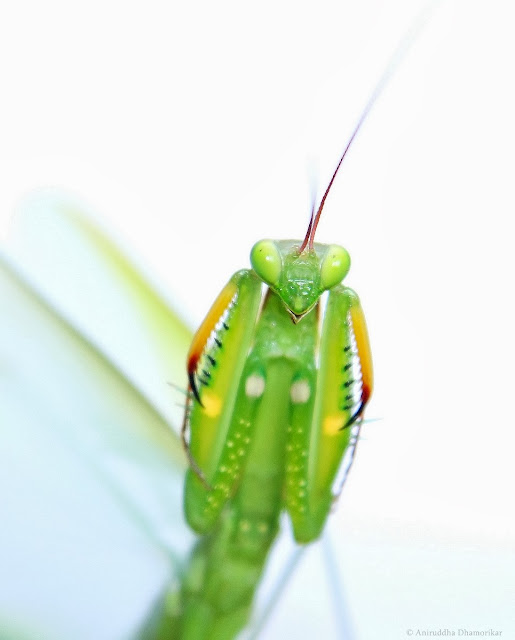 |
| The Praying Mantis (Mantis religiosa) in defensive pose |
Imagine yourself on a stroll through the forests, and coming
face-to-face with a mantis crossing the road by bobbing its body
back-and-forth. It does this to match the wind playing in the leaves, and it
believes that the dance is so cunning that you’ve probably not seen it, and so
it doesn’t mind you walking in its direction, until the vibrations in your
footsteps catches it by surprise, and it unfurls its wings, arches its thorax
upwards, and spreads out its knife-sharp raptorial legs – and to your horror,
hisses so well that you feel nothing but awe and surprise. This defensive
mechanism works well to surprise an intruder, and the closer you go into the
mantis’ comfort zone, the frightening it looks, if you were an insect.
But the bluff called by mantis is only to scare off the intruder.
There are others belonging to the undergrowth that show-off their brute
strength with not much ado: the scorpion.
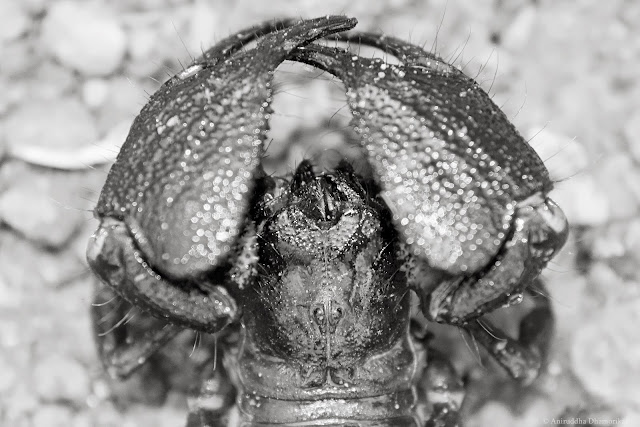 |
| The Giant Forest Scorpion (Heterometrus sp.) |
The scorpions, especially the Giant Forest Scorpion, do not
threaten or move about much when confronted with an intruder. They lay quiet, cover
their face with the enlarged pincers, and keep the stinger raised, in wait of
striking at the moment the limit of patience is crossed. The scorpion does not
bother itself with putting up aggressive display, for its reputation is well known.
The dog that does not bark bites.
 |
| The hunting party of Myrmicaria brunnea |
The most common animal you will confront on your way through
the forest is not Chital, nor Sambar, nor any bird, but an ant; lots of ants.
Ants unfortunately have a bad reputation probably because they bite and sting,
but more so because they do not have pretty names like the said deer species
they share their habitat with. Ants common in the Central Indian forests, which
peculiarly live on ground, are Myrmicaria
brunnea, Leptogenys processionalis,
and several species of Camponotus,
and Pheidole. Remembering one ant name is akin to
remembering titles to tigers of any nature reserve.
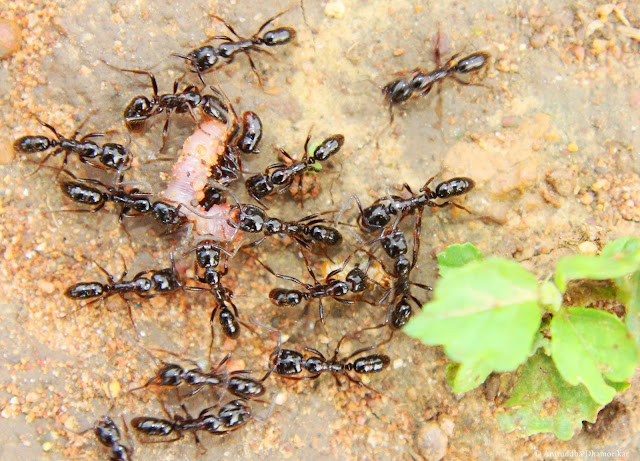 |
| The hunting party of Leptogenys processionalis |
But they’re here, most probably in numbers weighing more
than that of tigers of that reserve. Most of these ants are scavengers, but
also opportunists, with the ability to harvest seeds and leaves, herding aphids
and treehoppers, as well as hunting. Walking in forests is not dangerous just
because there lurk carnivores, but also because of ants. Camponotus ants depend upon their hard mandibles to tear flesh,
while M. brunnea and L. processionalis are notorious for
their sting that throbs and itches for a week after the first encounter.
Not all animals gang up to either kill or sting, however. There
are others that do so for protection, just like deer. In monsoons you are
likely to come across a mass of blood-red strings piling on top of one another,
travelling like a herd of Chital or Gaur. These little creatures are
millipedes, probably hatchlings.
| Herd of Millipedes showing the first wave |
These hordes eat and travel as a group. There is no one
leader to lead them, but they walk by piling on top of one another such that
the leaders of first lap (I call them the first wave) are overtaken by the
second wave which walk over the top of the first wave, and the third over the
second, and so on, until the first wave is the last to pile upon the last wave
to come back to the lead. No average herbivore, of the world, is capable of
such efficient movement system.
When disturbed, they travel in group, but the slowest are
left behind – but that is no matter for their aposematic colours warn the
predators that they are likely poisonous.
And last but not the least, the insect which even the
tiger-throbs would not forget – the butterflies. They do not form the core of
the insect diversity of Central India, but are an important species for their
aesthetic values.
 |
| Rabble of Danaines (Common Crow, Plain Tiger and Striped Tiger) on Heliotropium indicum |
Who would not want to see a butterfly, or a rabble of them,
fluttering about? The irony lies in what you like – the past-life or its
incarnation. I’ve come to observe that people, for obvious reasons, would like
to have butterflies visiting their gardens than their caterpillar which eat up
plants to become butterflies.
These animals, if I use the human hierarchical system, form
a layer over that of plants, or that slimy layer of oil which allows free
movement of the door of your car, or that rag-picker keeping your city streets
clean. They perform the most basic function for which they are unrewarded. In an ecosystem, however, they form the very core of wildlife. Wildlife
is not about marvelous animals and magnificent birds, but about life that is
independent of any human interference. And today, of all the animals, it is
insects, and a large number of arthropods, which are free from man’s dominion.
If I went to one and asked its opinion about this era being dubbed the
anthropocene, there sure could be a potential upheaval and a rebellion (and
likely human extinction).
We see the allegory of the more famous animals in the other
life, which renders us visionless to appreciate them in their true form. If only people would pay a little more
attention to the other life of the nature reserves, one would not have to
resort to the rhetorical use of figures of speech to signify this larger
diversity of life.
Comments
Post a Comment